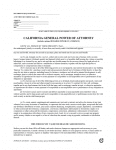California Durable Power of Attorney Form
The California Durable Power of Attorney, which is the official Uniform Statutory POA of California, provides an individual (called the “principal”) with a legal means to call on another party of their choosing to take over the management of one or more of their financial-related tasks. An inherent feature of the POA-type is that it will remain active in the event of the individual’s incapacity; in law, this is what makes the POA “durable.”
What Powers Can be Granted?
The form allows the principal to transfer power over the following areas, by initialing their name next to the designated power (in the POA):
- Real property transactions
- Physical personal property transactions (purchasing / selling)
- Stock and bond transactions
- Commodity and option transactions
- Banking and other financial institution transactions
- Business operating transactions
- Insurance and annuity transactions
- Estate, trust, and other beneficiary transactions
- Claims and litigation
- Personal and family maintenance
- Benefits from Social Security, Medicare, Medicaid, other governmental programs, or civil or military service
- Retirement plan transactions
- Tax matters
Laws + Signing Requirements
Laws: Part 3. Uniform Statutory Form Power of Attorney (§§ 4400 – 4409) & (§§ 4450 – 4465)
Signing Requirements (Division 4.5, Ch.2, § 4121): In order for the POA to be valid in CA, the principal must have either have:
- Two (2) witnesses view the signing of the POA.
OR
- A licensed Notary Public acknowledges the form.
Additional Considerations: Although the POA is, in fact durable, the principal can make it non-durable by crossing through bold text on the second (2nd) page that reads “This power of attorney will continue to be effective even though I become incapacitated.”
In addition to the standard POA, the form also includes information for both the principal and the agent. It’s important both parties read through said information to make certain that they understand exactly what they are signing as well as their obligations under the contract.
How to Write
Start by saving the POA in PDF or Word (.docx).
Page 1 – The Parties + Granted Powers
At the top of the first (1st) page, enter the:
- Principal’s name
- Principal’s address
- Agent’s name
- Agent’s address
Then, the Principal will need to write (or type) their initials next to each power they wish to grant to the Agent. While not mandatory, the Principal can cross out any powers they do not want to grant.
Page 2 – Special Instructions + Signatures
On the first three (3) lines at the top of the second (2nd) page, the Principal can modify (broaden or limit) the Agent’s powers in any way they so choose.
If the Principal does not want to make the POA durable, they can cross out the bold text as noted in the form. Otherwise, the POA will behave as a durable form. Additioanlly, if the Principal has more than one (1) agent, the Principal will need to write either “Separately” or “Jointly” depending on how they would like his/her Agent’s to act.
Enter the current date (day, month, and year) in the area specified, followed by the signature and Social Security Number (SSN) of the Principal.
Page 3 – Notarization
This page is to be completed by a Notary Public only.
Page 4 – Notice to Principal
The Principal should read the fourth (4th) page of the POA in full to ensure they understand their expectations and responsibilities. Once they have read the page, they will need to write their initials in the designated field.
Page 5 – Notice to Agent + Agent’s Signature
The Agent will need to read through the last page of the document, which contains their responsibilities to the Principal. If they agree with what is written, they will need to write their signature and printed name.
Related Forms
Download: PDF
Download: PDF


